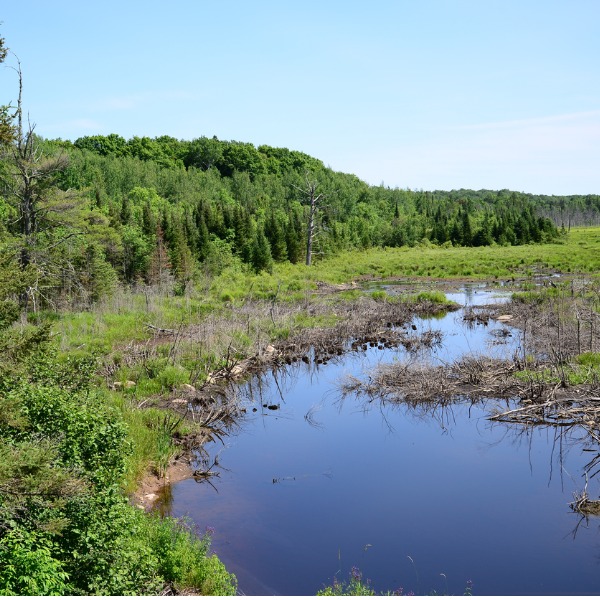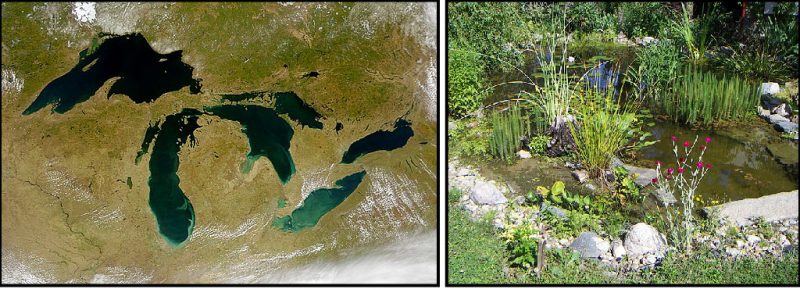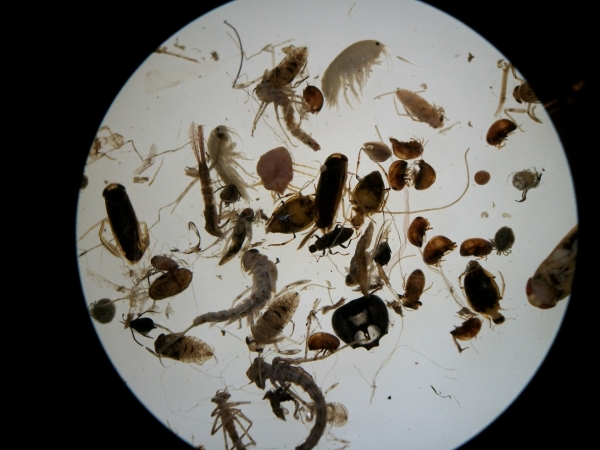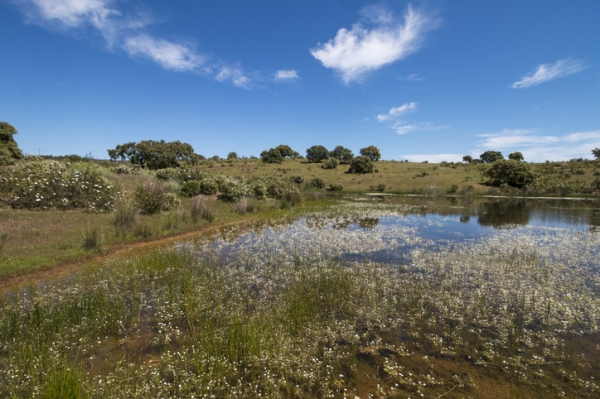Introduction to Lakes & Ponds

Pond in a valley (Tony Savino, iStockphoto)

Pond in a valley (Tony Savino, iStockphoto)
How does this align with my curriculum?
Learn about the geology, chemistry and ecology of lakes and ponds.
The Earth is made up of many different ecosystems. The ecosystems on Earth can be divided into two groups. Ecosystems on land are called terrestrial. Ecosystems in water are called aquatic. The two main kinds of aquatic ecosystems are freshwater ecosystems and marine ecosystems.
Freshwater ecosystems can be further divided into lentic ecosystems and lotic ecosystems. This backgrounder is about lentic ecosystems.
Lentic Ecosystems
Lentic ecosystems are in bodies of freshwater that do not flow. The word lentic comes from the Latin word lentus. This means slow or motionless. Lentic ecosystems can be as small as a garden pond or as big as the Great Lakes.
Did you know?
The freshwater lake with the largest area in the world is Lake Michigan-Huron. Geologists define Lake Michigan and Lake Huron as one body of water. This is because they are linked by the Straits of Mackinac.
There is no technical difference between ponds and lakes. But scientists generally identify a pond as any water body with an area smaller than five hectares or 50 000 m2. They identify a lake as a water body with an area larger than five hectares.
Image - Text Version
Shown are two colour photographs, one of the Great Lakes from the air, and one of a small pond surrounded by stones and plants.
The left image shows the five great lakes from the air. Three of them form a shape like a firework on a landscape. The other two are in a diagonal line across the lower right corner of the image. The water is dark greenish blue on light green land. There are thin areas of wispy clouds around the lakes. The right image shows a small pond with curved edges, filled with greenish brown water. The edges of the pond are lined with grey stones. Several different types of tall green plants grow up through the water and around the edges.
Geology
Lakes can be formed by a number of natural and artificial processes.
Huge sheets of ice called glaciers once covered almost all of Canada’s land surface. As the glaciers moved they created valleys and depressions in Earth’s surface. These filled with water when the ice melted.
This is how the Great Lakes, like Lake Michigan-Huron, were formed. Smaller lakes called tarns or kettles were also created this way. Many ponds and wetlands are also found on land that was once covered by glaciers.
In places where the land is low, meandering rivers often create oxbow lakes. This happens through a pattern of erosion and deposition. Erosion happens when rocks and soil are washed off the sides of rivers. Deposition happens when sediments like sand and silt build up in the river. These sediments can block the river. This causes a lake to form.
Image - Text Version
Shown is an aerial photograph of a long, curved lake next to a river.
The river is calm and beige. It meanders in large, deep curves, diagonally across the image. Behind the closest curve is a long thin lake in the shape of a wide, upside-down U. The river and lake are bordered with bushy green trees. There are more trees along the sharpest curves. The land around is a patchwork of green farmer’s fields.
Humans create many smaller ponds and lakes. A reservoir is an artificial lake built to store water or to generate hydroelectricity.. Its name comes from the French word réservoir. This means ‘storehouse’.
One way to make a reservoir is to dam a river. To dam something means to stop the flow of water using a barrier. Another way to make a reservoir is to dig a big hole in the ground and fill it with water. This is called a service reservoir. Farmers often build artificial ponds so animals have drinking water. People also build them as part of the landscaping around their homes.
Chemistry
The chemistry of a pond or lake depends on the land around it and the rock below it.
Lakes in mountain valleys are often low in organic matter. Organic matter comes from the breakdown of dead plants and animals. Lakes close to farms often have a lot of fertilizer and pesticides. Fertilizers are chemicals that help plants to grow. Pesticides are chemicals that kill weeds and insects that damage crops.
Lakes close to roads often have chemicals that come from things like motor oil and road salt. Cities can be a major contributor of chemicals to lakes. This is because sewage treatment plants release wastewater from homes and commercial or industrial buildings. Even though this wastewater has been treated, it can still contain harmful substances.
Fertilizers and sewage can upset the ecosystems of ponds and lakes. Fertilizers provide too much nitrogen and phosphorus to the algae living in ponds and lakes. This causes them to grow quickly and multiply. These algae then dominate the ecosystem, leaving little oxygen or sunlight for other species. This process is called eutrophication.
Ecology
Lakes and ponds have different ecological communities. This depends on their size, location and chemical characteristics. An ecological community is a group of plants and animals living in the same area.
Small ponds tend to have many phytoplankton and zooplankton. Phytoplankton are microscopic, free-floating plants. Zooplankton are microscopic, free-floating animals. The zooplankton feed on the phytoplankton and on each other in a tiny microscopic part of the food web. Small invertebrates also live in lakes and ponds. These might include insects like beetles or flies, worms, leeches or crustaceans like shrimp or crayfish.
Image - Text Version
Shown is a colour photograph of 20-25 tiny brown aquatic animals on a white circle.
The animals are different shades of brown, and different shapes and sizes. Small and round, medium and oval, and several almond-shapes. Some are long and curved, some are thin and stick-like. Every animal has thin legs. Some are short and close to the body, and some are long and hair-like.
Did you know?
Many insects, such as mayflies and dragonflies, can spend years as aquatic larvae.
The invertebrates and crustaceans feed on the phytoplankton and zooplankton, as well as other plants. In larger bodies of water, there might be enough plants and animals to provide food for larger animals. These could be fish, amphibians like frogs, toads, newts or salamanders, reptiles like turtles or snakes, and birds. Only the largest lakes contain the largest animals. There needs to be enough food for them!
Large lakes are important for large plants and animals. But ponds often have a wide variety of species for their size. This is because there are many ponds scattered across the landscape. These contain many different habitats that suit lots of different species.
Some ponds are acidic. They have low pH. Others are alkaline. They have high pH. Some are deep while others are shallow. Some are rich in nutrients while others have few nutrients.
Smaller ponds and lakes can also act as stepping stones. This means species that need fresh water can move through different habitats in the landscape. This is especially important as species move because of climate change.
Finally, some ponds are small and not connected. So if there is a problem in one pond, like pollution, the damage will be limited. It will be contained in that pond, or maybe nearby ponds. But in a lake where all of the water is connected, damage can spread and affect many plants and animals.
Temporary ponds form in different ways. Sometimes it’s when snow melts or rain falls in the spring and fills a depression in the earth. Or it could be something that forms after a heavy rain. Temporary ponds only last for a short time before the water dries up. But they are still home to a number of animals!
Fish don’t usually live in temporary ponds. This is because they can’t survive if the ponds dry out. Also, they also can’t transport themselves to new ponds. But many smaller animals, like tadpoles and aquatic insects, thrive here without fish to eat them.
Some animals that live in temporary ponds have specific characteristics. These characteristics allow them to survive occasional, sometimes unpredictable, times of low precipitation.
Image - Text Version
Shown is a colour photograph of a low, grassy area filled with water.
Green grasses and plants with tiny white flowers grow up through the shallow water. The muddy brown lakebed is visible below. The water fills the area between two low, pale green hills dotted with dark green shrubs. The sky above is bright blue with a few wispy white clouds.
One of these is the water flea Daphnia, which has adapted to droughts. Others, like dragonflies, can easily move between water bodies. So, they can establish themselves in ponds when they become filled with water, and find a new habitat when they dry up.
So, whether they are tiny or vast, lentic bodies of water are all incredibly important to biodiversity on Earth!
Learn More
Oxbow Lake Formation Animation (2021)
This video (1:47 min.) by Oxbow Meadows Environmental Learning Centre, illustrates how oxbow lakes form from the bends in rivers.
river time lapse - Ucayali river time lapse (2018)
This short video (0:45 min.) by Satellite timelapse shows how the Ucayali River created oxbow lakes over a 33 year period.
How do glaciers shape the landscape? (2015)
This video (2:30 min.) by Oxford Education illustrates how glaciers change the landscape through erosion, transportation and deposition.
Think you know the Great Lakes? Here are some little-known facts (2021)
This video (2:21 min.) by The Weather Network fills you in on all sorts of fascinating facts about the Great Lakes.
How these water fleas could save your water quality — and your life (2019)
In this video (2:52 min.) by PBS NewsHour, ecologist Megan Duffy explains how Daphnia water fleas maintain their own health, and the health of the water where they live.
References
Hoverman, J. T. & Johnson, P. T.J. (2012) Ponds and Lakes: A Journey Through the Life Aquatic. Nature Education Knowledge, 3(6):17.
National Geographic Resource Library. (2011 January 21). Reservoir.
National Geographic Resource Library. (2011 September 15). Lake.
Richardson, D.C., Holgerson, M.A., Farragher, M.J. et al. (2022, June 21). A functional definition to distinguish ponds from lakes and wetlands. Sci Rep 12, 10472. https://doi.org/10.1038/s41598-022-14569-0. Nature.com
Stollewerk, A. (2010). The water flea Daphnia - a 'new' model system for ecology and evolution? Journal of Biology, 9(2): 21.DOI: 10.1186/jbiol212
World Atlas. (n.d.) Types Of Lakes Formed By A Glacier.



